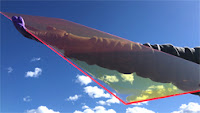Friday, June 26, 2020
World record lightning ‘megaflash’ in South America — 440 miles long — confirmed by scientists
Storm that produced the world's longest certified lightning discharge in 2018, WMO image.
“This dramatic augmentation of our space-based remote sensing capabilities has allowed the detection of previously unobserved extremes in lightning occurrence,” said Michael J. Peterson of the Space and Remote Sensing Group of Los Alamos National Laboratory in New Mexico.
Albrecht explained that, before the days of GOES 16, satellites could scan for lightning only in brief windows. That meant the vast majority of events were missed.
“We have measurements every two milliseconds with the [Global Lightning Mapper],” said Albrecht. “And we have all the chances to see those across the Americas, and also over the Pacific Ocean. [Europe] will launch their sensor in a couple of years, [and] China has a similar sensor.” (Full Story)
Also from Forbes
How dynamite shaped the world
Nobel’s Extradynamit, a later version of dynamite he sold in 1875, from PopMech.
To understand why dynamite was so revolutionary, says Larry Glenn Hill, a detonation physicist with Los Alamos National Laboratory’s High Explosive Science and Technology group, you have to understand the instability of its precursor.
“Detonation is a wondrous and highly specialized process, which involves the cooperation of two structures,” Hill explains. “The first is a shock wave, and the second is a burn wave.” A shock wave is a sharp rise in pressure, temperature, and density that travels at supersonic speeds. Picture it as the motion that occurs when you release a tightly coiled spring. As all that energy is expended, it produces heat, which is responsible for the fiery part of an explosion. “A detonation can be viewed as a burn-supported shock wave, or a shock-triggered burn wave; however one chooses to look at it. It is either and both.” (Full Story)
Perseverance mission scientist outlines rover’s instruments, mission
Mars Perseverance Rover, NASA illustration.
One month before the scheduled launch of NASA’s Perseverance Mars rover, Roger Wiens, who serves as both principal investigator of its SuperCam laser instrument and as co-investigator of its SHERLOC team, discussed the mission’s science instruments and its purpose in a virtual webinar presented by the Lunar and Planetary Institute (LPI).
In a presentation titled “NASA’s Perseverance Rover and the Prospect of Round-Trip Robotic Missions,” Wiens, of the Los Alamos National Laboratory, outlined the details of the first-ever Mars sample return mission in the context of the space agency’s decades-long exploration of the Red Planet. (Full Story)
Low-cost quantum dot windows could power a solar future
LANL photo.
Newly developed luminescent solar concentrators can help turn these large glass facades into power generation units. Window-based collectors have the potential to far exceed the output of rooftop panels in major cities as a result of the larger surface area.
To transform a window into a luminescent solar concentrator, our team at Los Alamos National Laboratory has developed a technique for depositing a layer of a fluorescent material on the glass surface. (Full Story)
Creative Diagnostics expands response to COVID-19 to recombinant SARS-CoV-2 RBD mutants
Covid-19, CDC image.
Due to the complexity of SARS-CoV-2, there are currently no vaccines or drugs available for the prevention and treatment of COVID-19, showing an emergent need for effective prevention and treatment measures.
"The research of Los Alamos National Laboratory shows that a major D614G mutation on SARS-CoV-2 Spike has emerged in European countries," said a senior scientist at Creative Diagnostics, "and this D614G mutation may make the virus more transmissive. So, it's of great importance to understand the biology of this variant, especially concerning the research and development of vaccine and drug." (Full Story)
New Mexico watching COVID-19 spike in neighboring states
Covid-19, NIH image.
The state’s lead doctor who’s helping guide New Mexico through the pandemic, once again gave a status update on where the state stands with COVID-19, and where we could be headed. Doctor David Scrase, Secretary for the Human Services Department went through a lot of data on Friday, and addressed concerns about spikes in our neighboring states.
Dr. Scrase said the state is also working closely with Los Alamos National Labs to track mobility as it relates to virus spread rate. LANL modeling shows a close correlation between travel and rate of spread. (Full Story)
The Vet who protects Los Alamos National Laboratory
Jesse Galvan, US Army photo.
Retired Army Colonel Jesse Galvan once kept the nation’s Army bases safe from threat, and now he’s continuing that work in Los Alamos. Around the Lab, we’re used to seeing Protective Force (Pro Force) officers checking ID at the front entrance or patrolling the grounds in their white SUVs.
“You never really see all that we’re capable of, and that’s the point,” Galvan says. “But rest assured we are capable of addressing and defending the Lab against any threat out there.” (Full Story)
To subscribe to Los Alamos Press Highlights, please e-mail listmanager@lanl.gov and include the words subscribe PressHighlights in the body of your email message; to unsubscribe, include unsubscribe PressHighlights.
Please visit us at www.lanl.gov














